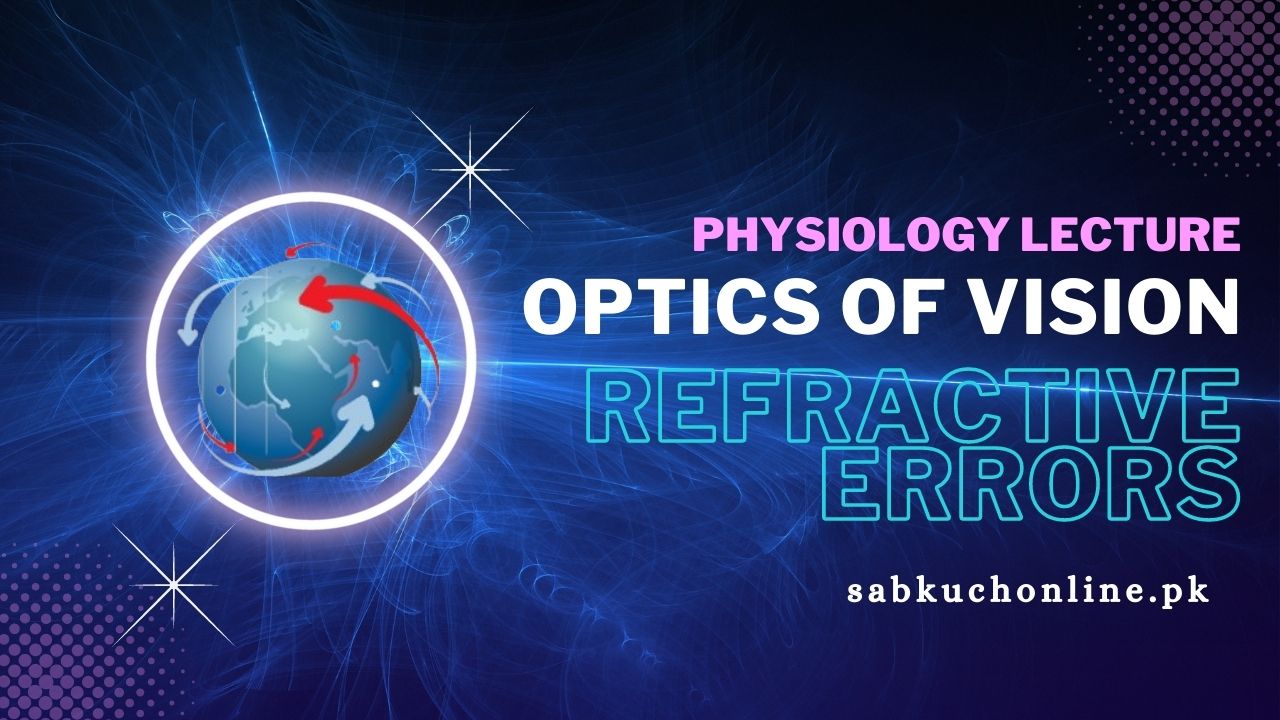Learning Outcomes
By the end of lecture students should be able to:
- Explain refraction.
- Explain concept of convergence and divergence.
- Define focal length, focal point and power of lens.
- Comment on physiological anatomy of eye.
- Differentiate between emmetropia, myopia, hyperopia,
astigmatism, presbyopia - Summarize their treatment.
Special Senses
- Sensory receptors are grouped into special organs known as
special senses
- Eyes– Vision
- Ear– Hearing
- Taste Buds– Taste
- Olfactory membrane– Smell
Vision
- Eyes are composed of
•OPTICAL COMPONENTS - Multiple interfaces and media
•NEURAL COMPONENTS - Receptor
- Visual Pathway
- Visual Cortex
Introduction
- Light travel through air at velocity of 300,000km/sec
- Travel slower in dense medium
- Refractive index– ratio of velocity of light in air to velocity of
light in the substance
300,000:200,000
1:0.50
- All the rays pass through a single point– Focal point

Refraction
- Light passes through angulated surface- light rays bend because of
change of media - Bending of light at an angulated surface– Refraction
- Refraction depends upon
- Refractive indices of two media
- Degree of angulation
- Mechanism that helps to focus light on retina

Components of the Eye’s Optical System
- Cornea
- The anterior chamber
- The iris and pupil
- The crystalline lens
- The retina
Lenses
- 2 types
- Spherical lenses
Converge or diverge light in both the planes(vertical and
horizontal) - Cylindrical lenses
Converge or diverge light in one planes
•Convex lens
- Convergence of light on to a single focal point
- Light rays passing through the center do not refract
- Light rays towards outer surfaces bend more– converge
- Stronger the lens more will be convergence

•Concave lens
- Divergence of light on to a single focal point
- Light rays passing through the center do not refract
- Light rays towards outer surfaces bend more– diverge
- Stronger the lens more will be divergence

Focal Point
- Light rays that pass through the spherical lens are refracted
at all edges of the lens (in both planes) toward the central
ray, and all the rays come to a focal point.
Diopter
- Refractive power is measured in diopter
- Reciprocal of focal length (1/f)
- More a lens bend light rays more is the power of lens
- Power of lens expressed in
- Convex lens– +
- Concave lens— –

Cylindrical lens
- A cylindrical lens is a lens which focuses light into a line
instead of a point, as a spherical lens would. - Light from two different sides bend in one plane and form a
focal line

Physiological Anatomy of Eye







Errors of Refraction
Emmetropia
- Emmetropic eye—normal
- Equal measure– no refractive error– desirable optical system
- When parallel light rays from distant objects are in sharp
focus on the retina when the ciliary muscle is completely
relaxed - Emmetropic eye can see all distant objects clearly when
ciliary muscles are relaxed - For focusing near object ciliary muscles must contract for
clear vision– accommodation

Ametropia
- Parallel rays do not fall on retina, when ciliary muscles are
relaxed - Includes
- Far sightedness (Hyperopia)
- Near sightedness (Myopia)
- Astigmatism
- Presbyopia
Hyperopia
- Far sightedness
- Focusing parallel rays of light behind retina, when ciliary
muscle is fully relaxed - Clear distant vision
- Distant objects will be focused on retina by contraction of
ciliary muscles - ERROR
- Defective near vision
- Causes
- Short eyeball
- Weak lens system
- Presentation: Headache
- Due to continuous contraction of ciliary muscles
- Correction:
- Convex lens


Myopia
- Near sightedness
- Focusing parallel rays of light in front of retina, when ciliary
muscle is fully relaxed - Clear near vision
- No mechanism to reduce lens power
- ERROR
- Defective far vision
- Causes
- Excessive long globe (axial myopia) : more common
- Excessive refractive power (refractive myopia)
- Increase in the curvature of the cornea or the surfaces of
the crystalline lens - Near objects will be focused on retina easily
- When the far object is brought closer accommodation bring
about the clarity of image - Correction
- Concave lens


Astigmatism
- Focusing of light rays along two different lines
- Cornea or lens don’t have same refractive power in both planes
- Eye’s lens system
- Combination of two cylindrical lenses of unequal powers placed at
right planes
Causes
- Abnormal curvature of cornea and lens in one or both the
planes - Treatment
- Cylindrical lens (problem in one planes)
- Cylindrical and spherical lens (problem in both planes)
Presbyopia
- Physiologic loss of accommodation in advancing age
- Deposit of insoluble proteins in lens in advancing age
- Elasticity of lens progressively decrease—decrease in
accommodation - Around 45 years of age , accommodation become less than
3D reading is possible at 40-50 cm - Difficultly reading fine print , headache , visual fatigue
- Treatment
- Convex lenses in near vision
- Reading glasses
- Bifocal glasses
- Progressive power glasses
